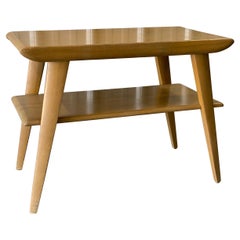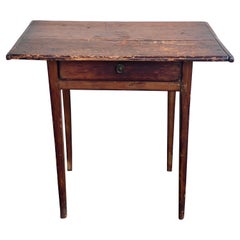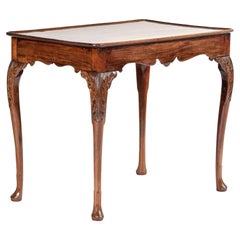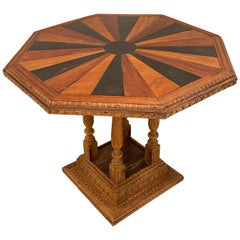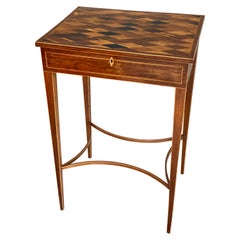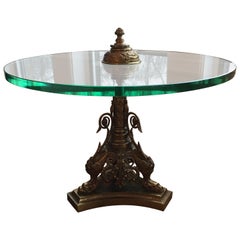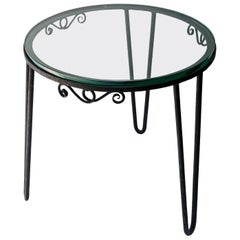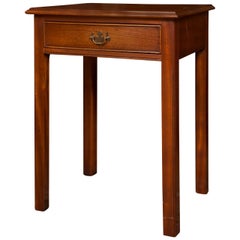Kitty Clay End Tables
to
1
Height
to
Width
to
Depth
to
6
6
2
1
1
2
3
2
5
2
2
2
2
3
2
2
1
1
6
6
6
1
1
Mid-Century Modern Heywood Wakefield Maple Two Tiered Side Table
By Heywood-Wakefield Co.
Located in Southampton, NY
Mid-Century Modern Heywood Wakefield Maple Two Tiered Side Table
Two tiers, made of maple, stamped 'Heywood Wakefield' underside.
15" deep x 28" wide x 21" high
Good overall condit...
Category
Mid-20th Century American Mid-Century Modern Side Tables
Materials
Wood, Maple
American Single Drawer Rustic End Table, 20th Century
Located in Southampton, NY
American single drawer rustic end table, 20th century.
Charming simple rustic table with clean lines, tapered legs, and a round brass knob. Some separation to the top. Knicks and we...
Category
20th Century American End Tables
Materials
Brass
Irish George III Carved Mahogany Dished Top Tea Table, 18th Century
Located in Southampton, NY
Irish George III carved mahogany dished top tea table, 18th century
Beautifully hand carved foliage, slightly curved cabriole tapered legs on padded feet.
Old Tag from Edward Butler...
Category
Antique 18th Century Irish George III Card Tables and Tea Tables
Materials
Mahogany
19th Century Dutch Ceylonese Specimen Table
Located in Southampton, NY
19th century Dutch Ceylonese specimen table, circa 1890. Handmade in the Dutch style with a Ceylonese twist on the base in Sri Lanka. Various woods include: Nadoun, satinwood, mahoga...
Category
Antique Late 19th Century Sri Lankan Dutch Colonial Tables
Materials
Ebony, Mahogany, Satinwood
Unusual George III Inlaid Rosewood and Specimen Wood Parquetry Work Table
Located in Southampton, NY
Unusual George III inlaid rosewood and specimen wood parquetry work table, circa 1800.
The hinged rectangular parquetry top inlaid with specimen woods in a lattice pattern and over ...
Category
Antique Early 19th Century English George III Tables
Materials
Ebony, Kingwood, Satinwood, Yew
$3,200 Sale Price
33% Off
Maison Charles Glass and Bronze Round Table, One of a Kind, 1960s
By Maison Charles
Located in Southampton, NY
Maison Charles glass and bronze round table, one of a kind, French, 1960s. Excellent condition. Very elaborate and clearly articulated bronze work. Chubb insurance appraisal noted fr...
Category
Mid-20th Century French End Tables
Materials
Bronze
Related Items
Round Black Metal 1960s Italian Side Table with Glass Top
Located in Los Angeles, CA
Round black metal Italian side table from the 1960s with thick glass top.
Category
Vintage 1960s Italian Mid-Century Modern Side Tables
Materials
Metal
Mahogany Single Drawer Side Table
Located in Woodbury, CT
Constructed of solid mahogany, this little side table could find a home just about anywhere-bedside, next to a sofa or wing chair, as a catch-all for keys and gloves in a side hall-a...
Category
21st Century and Contemporary British Georgian Side Tables
Materials
Mahogany
Maison Bagués Attribution, Side Tables, Bronze, Mirrored Glass, France, 1930s
By Maison Baguès
Located in Manhasset, NY
Pair of Hollywood Regency Bagues style gilt bronze neoclassical end tables or pedestals. These simply stunning end tables, pedestals or nights...
Category
Mid-20th Century French Neoclassical End Tables
Materials
Bronze
$12,960 / set
H 18.25 in Dm 21.25 in
Oak Rustic End Table
Located in Westwood, NJ
An oak parquetry rustic end table with parquetry patterned top and bottom tier with square tapered legs.
Shown in dawn finish.
Dimensions: 24" W x 24" D x 22" H.
Category
21st Century and Contemporary Vietnamese Rustic End Tables
Materials
Wood
Specimen Marble Top, 19th Century
Located in Saint-Ouen, FR
Specimen marble top. 19th century.
Category
Antique Early 19th Century French Decorative Art
Materials
Marble
Pair of Haywood Wakefield Art Moderne 2-Tier Maple End Tables
By Heywood-Wakefield Co.
Located in Queens, NY
Pair of American Art Moderne 2 tier maple end tables with bentwood design and wicker trim. (Stamped: HAYWOOD WAKEFIELD) (PRICED AS Pair)
Category
Vintage 1940s American Mid-Century Modern End Tables
Materials
Maple, Wicker
$1,350 / set
H 22.5 in W 14 in D 28.25 in
Mid-Century Modern Octagonal Two Tiered Side End Table Adrian Pearsall for Lane
By Lane Furniture, Adrian Pearsall
Located in Lambertville, NJ
Sculptural Mid-Century Modern octagonal side, end or drinks table by Lane Furniture. Sleek and stylish and very unique. Features gorgeous walnut wood frame with a beautiful parquetry...
Category
Vintage 1970s Mid-Century Modern Side Tables
Materials
Wood
$750
H 20 in W 25.5 in D 25.5 in
Victorian Round Wicker Two Tier Side Table by Heywood-Wakefield Co.
By Heywood-Wakefield Co.
Located in Miami Beach, FL
This 1898 wicker table is an excellent example of Heywood Bother's and Wakefield Company Victorian Era. It features a combination of an apron using wooden beads as well as birdcage s...
Category
Antique 1890s American Victorian Side Tables
Materials
Wicker, Beads
A Fine George III Painted Satinwood Card Table, 18th Century
Located in ARMADALE, VIC
A Fine George III Painted Satinwood Card Table, 18th Century
Provenance: Private Australian Collection.
Description:
The hinged D-shaped top inlaid with a banded border painted wit...
Category
Antique 18th Century English George III Card Tables and Tea Tables
Materials
Satinwood
Early 20th Century Anglo Indian Occasional Table
Located in London, GB
Early 20th Century Anglo Indian occasional table
We share what we love, and we love this aged hard wood example of a large Anglo Indian hard...
Category
Vintage 1920s Indian Victorian End Tables
Materials
Wood
George III Mahogany Work Table
Located in Essex, MA
Oval hinged top and open interior over a conforming case with faux drawers and working drawer.
Square splayed legs and X form stretcher. With key.
Category
Antique 1790s English George III End Tables
Materials
Mahogany
Vintage Heywood Wakefield Birch Maple Champagne Step End Tables, a Pair
By Heywood-Wakefield Co.
Located in Philadelphia, PA
Vintage Heywood Wakefield Birch Maple champagne step end tables - a pair . Item features a solid wood construction, beautiful wood grain, origi...
Category
Mid-20th Century American Mid-Century Modern End Tables
Materials
Maple
$695 / set
H 22 in W 15 in D 28 in
